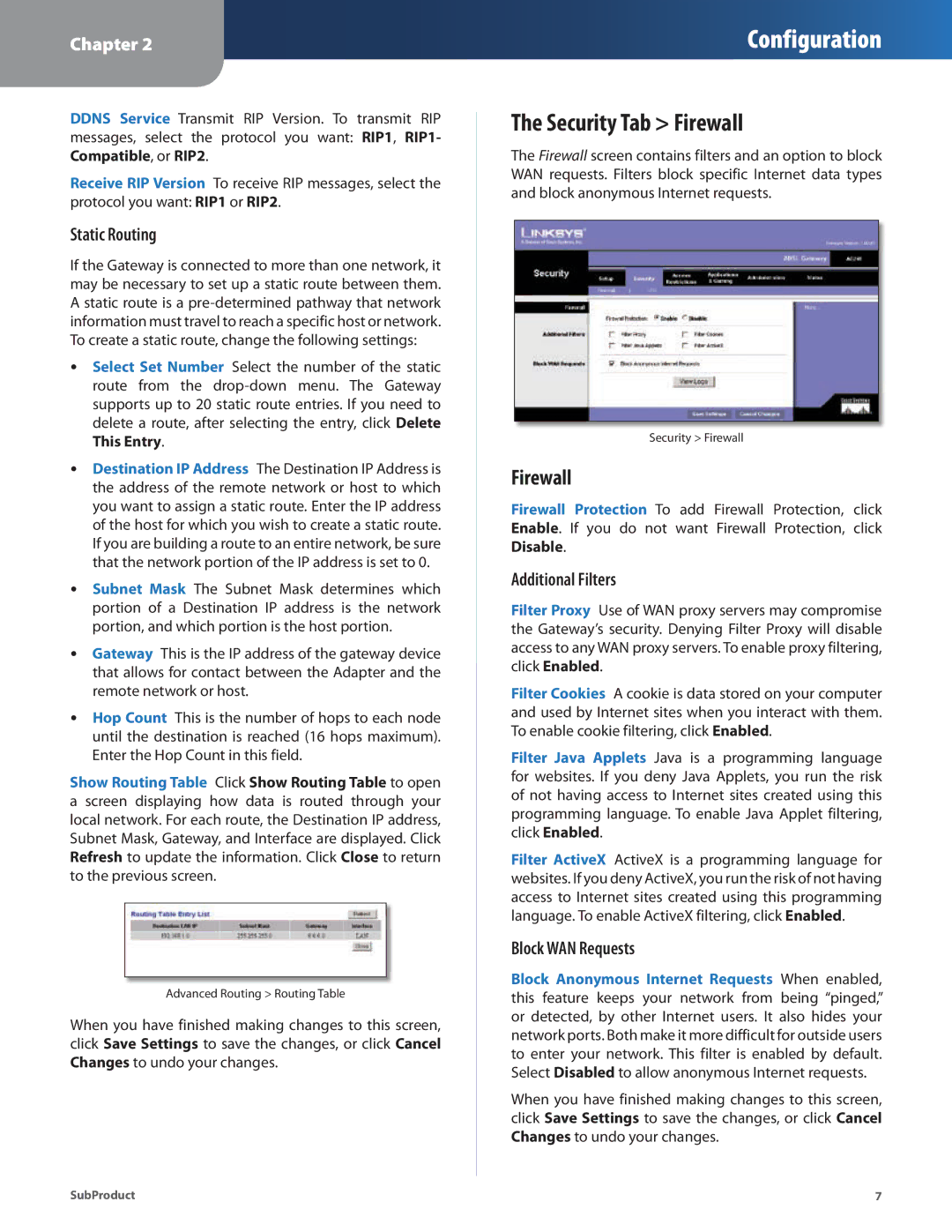
Chapter 2
Configuration
DDNS Service Transmit RIP Version. To transmit RIP messages, select the protocol you want: RIP1, RIP1- Compatible, or RIP2.
Receive RIP Version To receive RIP messages, select the protocol you want: RIP1 or RIP2.
Static Routing
If the Gateway is connected to more than one network, it may be necessary to set up a static route between them.
Astatic route is a
•• Select Set Number Select the number of the static route from the
This Entry.
•• Destination IP Address The Destination IP Address is the address of the remote network or host to which you want to assign a static route. Enter the IP address of the host for which you wish to create a static route. If you are building a route to an entire network, be sure that the network portion of the IP address is set to 0.
•• Subnet Mask The Subnet Mask determines which portion of a Destination IP address is the network portion, and which portion is the host portion.
•• Gateway This is the IP address of the gateway device that allows for contact between the Adapter and the remote network or host.
•• Hop Count This is the number of hops to each node until the destination is reached (16 hops maximum). Enter the Hop Count in this field.
Show Routing Table Click Show Routing Table to open a screen displaying how data is routed through your local network. For each route, the Destination IP address, Subnet Mask, Gateway, and Interface are displayed. Click Refresh to update the information. Click Close to return to the previous screen.
Advanced Routing > Routing Table
When you have finished making changes to this screen, click Save Settings to save the changes, or click Cancel Changes to undo your changes.
The Security Tab > Firewall
The Firewall screen contains filters and an option to block WAN requests. Filters block specific Internet data types and block anonymous Internet requests.
Security > Firewall
Firewall
Firewall Protection To add Firewall Protection, click Enable. If you do not want Firewall Protection, click Disable.
Additional Filters
Filter Proxy Use of WAN proxy servers may compromise the Gateway’s security. Denying Filter Proxy will disable access to any WAN proxy servers. To enable proxy filtering, click Enabled.
Filter Cookies A cookie is data stored on your computer and used by Internet sites when you interact with them. To enable cookie filtering, click Enabled.
Filter Java Applets Java is a programming language for websites. If you deny Java Applets, you run the risk of not having access to Internet sites created using this programming language. To enable Java Applet filtering, click Enabled.
Filter ActiveX ActiveX is a programming language for websites. If you deny ActiveX, you run the risk of not having access to Internet sites created using this programming language. To enable ActiveX filtering, click Enabled.
Block WAN Requests
Block Anonymous Internet Requests When enabled, this feature keeps your network from being “pinged,” or detected, by other Internet users. It also hides your network ports. Both make it more difficult for outside users to enter your network. This filter is enabled by default. Select Disabled to allow anonymous Internet requests.
When you have finished making changes to this screen, click Save Settings to save the changes, or click Cancel Changes to undo your changes.
SubProduct | 7 |
